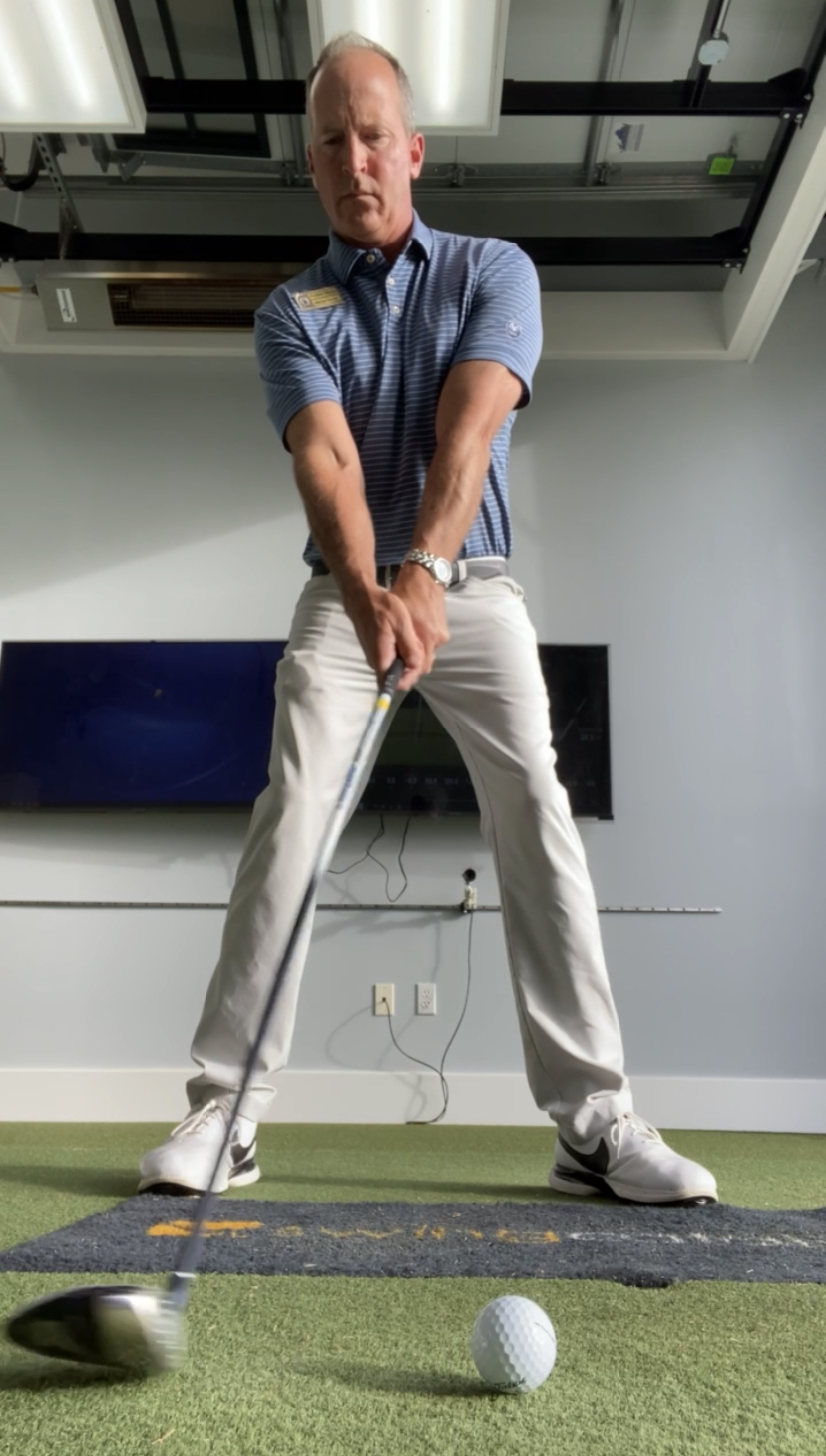Should I take a divot with my irons? Is it bad if I don’t?
Divot YES--but in FRONT OF THE BALL
Divots are good BUT–they need to be in front of the ball and they don’t need to be deep gouges. Depending on the turf most PGA and LPGA Tour players take divots that are like 2″ wide 4″ long scalps. The divots starts at about 1/2″ in front of the ball.
Most mid to high handicap players try to help (scoop) the ball up in the air, when they do this causes them to either hit the ground behind the ball or not hit the ground at all and either hit the ball way up in the air or thin.
The key to taking a divot is first to make sure to shift the lower body weight into the lead side to start the swing down, then hold the angle between the lead arm and the shaft until about waist high. This will keep the grip end of the club in front of the head of the club and cause the club to bottom out in front of the ball. This is not something that can be forced but is a result of doing the right things in the swing sequence wise.
Here’s the best way to learn to take divots:
Take one of your wedges, draw a line about 3′ long perpendicular to your target line. Position that line about 2″ back of your lead heel. Making ONLY CHIP swings (no bigger than waist high to waist high) and without a ball, focus on holding the angle mentioned above, hands leading (ahead of) the club head and try to brush the ground in front of the line. No gouges just scrapes and make sure to square the face up! Work all the way down the line until you get to the end, notice how many times you scraped the ground and how many times that scrape is in front of the line. If you have a lot of scrapes and they are in front start over and set a ball on the line so that you can make 2-3 practice swings, then hit the ball with the same motion and intent as without.
As you get better at this with a ball start making the swings bigger.
All Your Technique to Influence Your Divot
Taking a divot with irons is a byproduct of your impact conditions (Angle of Attack, Dynamic Loft, Club Head Speed, Swing Direction, etc.) and the turf conditions (grass type, firmness of turf, moisture level, etc).
In general, we often see Tour players take larger divots while amateurs may struggle to take any. Whether this is good or bad depends on your technique and ball flight preferences (whether you like to hit draws or fades) to a large extent. A good coach can help analyze your performance and make a recommendation.
However, as a general statement, understand that the slower your club head speed the shallower your swing should become and less divot you should take. The faster your swing speed, the more divot you can take. So, while you might think it would be cool to take a beaver pelt divot off bent grass like a Tour player, if you do not have the speed and impact conditions to support it, adjusting your swing to create such a divot may not be the best option. In fact, many amateurs would actually benefit from shallowing their swing, thereby often reducing the amount of divot they take.
Two of the greatest ball strikers ever, Jack Nicklaus and Greg Norman, did not take much of a divot due to their technique and ball flight preferences. The key to recognize is that the divot is mostly a byproduct of your technique and club speed. Get those right, and you’ll take the correct divot for you.
Really want to improve your golf game? Get incredible swing tips delivered to your inbox every week.
It depends!
It depends is a common answer I give to my students often in response to many questions. The old school answer is yes you should take a divot with irons just like a dollar bill shape. But it depends on many factors if you should take a divot with irons.
1) what turf do you play on? If zoysia like my club Old Hickory the ball sits up so high that a divot may not be required. If tight bent or bermuda probably yes.
2) what club is it? SW or PW probably so as they have more shaft lean as compared to say a 4i which is probably little or no divot.
3) what is your Trackman Angle of Attack? I have seen players with a -7 AoA who take no divot and players with +1 or higher take huge chunks.
So the answer is it depends! If your angle of attack is negative with irons and your club path is between -3 and +3 if you take a divot Great! If you don’t Great! If your angle of attack is too shallow and positive and your path is outside those parameters then find an instructor that can help!
An emphatic yes!!
Yes and yes. The low point of a proper swing is 4+ inches in front of the ball. We want ball first contact on all shots from the ground. I learned from Tom Kite that it was desirable to take a small divot with a fairway wood, now a fairway metal. We use the ground as a launching pad for the ball. A descending swing uses the force of the ground pushing back to get the ball up in the air with more spin.
Learn to hit the ball with the grip end of the club closer to the target then the club head at impact and you are starting to use the club correctly. For many golfers the ball will not go at the target because their lead wrist is not flat enough at impact or their grip is incorrect.
See a PGA Professional who understands impact to get this fixed.
Iron play and divots
Okay, so there are many great players who have a shallow angle of attack and don’t take much of a divot. But, a slight angle of attack with some shaft lean will give your max compression, distance and spin on iron shots. In my opinion, it would be beneficial to be multiple.
When you play certain grasses like zoysia, the ball really sits up because the blades are strong. With that being said, it is easy to “sweep” it off the turf and hit quality golf shots.
Also, when you are hitting irons off a tee, you can hit great iron shots by being very level with your angle of attack, especially with long irons. But, when you play courses where grass is mown closely to the turf, it is difficult to hit the sweet spot in all the grooves unless you have a negative angle of attack which leads to divots.
This holds true for irons, hybrids and even fairway woods.
Don’t Try to Make a Divot, Let it Happen
Any ball that is on the ground must be compressed to get it airborne. With your irons and wedges you should definitely see some turf move when hitting a shot. That being said, does it need to be a chunk of turf or a brush of the turf? Either can work but I prefer to see my players use the sole of the club in a shot for proper contact. If you see dirt and grass 6 grooves up the face your angle of attack is too steep. Work more body rotation into your action to help this and try to end up in balance with proper weight shift. Love to see the club drop on the ball and compress the ball with the use of gravity, don’t force the divot.
Good luck and quit digging up my range!!
Divot or No Divot? It Depends!!
It is definitely true that most of the great iron players took a divot after they struck their golf ball. That being said the many of the greatest ball strikers of all time took shallow divots or no divot unless the shot required them to do so. There are so many different lies that the ball will find itself in throughout a round of golf. If the ball is sitting high up on top of the grass there is no reason to carve out a divot. If the ball is nestled down tightly then a steeper angle of attack which would create a deeper divot would be advantageous for solid contact. The accomplished player knows how and when to adjust their angle of attack on the golf ball.
One of the biggest differences between skilled and lesser skilled players is low point awareness and low point control. Understanding that the swing is an arc can help the player learn how low point works. Every swing goes up, comes back down and then goes up again. Within that arc there is a low point. Ideally this low point should be either at the very bottom of the ball for someone that doesn’t take a divot or up to 4 inches in front of the ball if the player is taking a standard dollar bill size divot.
I believe it can be very damaging to a player’s development to be told to “hit down on the ball“. I think it is much better for the new golfer to learn to cut the grass with the blade of the club. Once the player learns to clip the grass it’s much easier for them to further develop the skill of making the club go into the grass deeper which would create more of a divot. There is a big difference between “hitting down” and the club contacting the ball on the descending side of the swing arc.
More Consistent with a divot
There are tons of ways to swing a golf club and none of them are wrong. However, you will be more consistent with your ball striking if you can take a divot. Without taking a divot your swing is most likely too flat which will bring skulls and thin shots into play.
Focus on bringing the club back “closed”. This will ensure a steeper backswing and a divot at impact.
Absolutely!
Go to a tour event sometime and take a look at the perfect divots of tour pros. A divot is evidence of a solidly struck golf shot. The more in to out (drawer) of the ball the less the divot. The more you play a cut generally the more divot you will take.
Optimum Trackman data tells us an ideal iron shot has a path of 2 left and a downward angle of attack. Those numbers would most certainly produce a divot. In the old days (pre video) all you had was the divot, the sound, and the ball flight. Ben Hogan famously said “your swing is in the dirt go find it!” Further evidence that a divot is absolutely essential to consistent iron play!
Sweep it!
You are probably sick and tired of hitting fat shots! Sweep it, don’t dig it! Here’s how: play your golf shot directly in the center of your stance. Use a soft grip pressure. Drag the club back, low to the ground. This is the key! Most chunked shots happen when players pick the club up off the ground, too abruptly, during the backswing. Swing back slow and low (that is the TEMPO)! You will sweep the turf and find the center of the sweet spot with ease! Enjoy!
Divots: What? Me Worry?
The question at hand is interesting, because the answer depends.
Rule #1: Ball flight doesn’t lie. If you are happy with your ball flight, whether you take a divot is irrelevant. Some of golf’s best rarely take a divot. Others take half an acre of sod with them.
Rule #2: If you are having contact problems, read your divots. A deep divot with occasional solid contact may indicate too steep of an angle of approach caused by some earlier flaw, resulting in glancing impact. Shall divots, or absence thereof and a spraying shot pattern may indicate too flat of a swing plane. A lesson may be in order to determine the best correction. But again, if you’re happy with your ball flight, don’t worry about it.
DIVOT IS A MUST
This is one of the most misunderstood concepts in golf. In order to insure the most solid contact a divot should always be taken on the target side of the golf shot. Ball then divot. That being said some divots are deeper than others but should always be taken with every club in the bag other than driver and putter.
Yes
Yes, the Tour average is 3 to 5 degrees down with irons which means the club is traveling down and takes a divot. There have been a few great players that sweep it more, so much depends on the individual skill level.
Most players do - but it’s okay if you don’t.
If you watch all the best players on the international tours, most take a divot when hitting a full swing, short iron. I believe this is because the angle of attack is slightly steeper than that of a long iron or fairway metal. This ensures ball first contact, which creates spin.
Many of my students ask “how do I put spin on the ball;” this is what I teach them. That’s not to say that being a “sweeper“ is a bad thing, but I believe a shallower path leads to higher trajectory shots that have less spin. I like to see a lower, more boring trajectory with spin to control short irons. That’s why more lower handicap players will take a divot with short irons (5i-pw).
Always Wondered about Divots
I’ve played golf for twenty five years, and have taught golf for nearly twenty. But if a player takes proper posture (which soles the club AT ground level) and makes a proper swing (maintains posture throughout the swing and returns the head to the address point), why should the club enter the turf below the spot where the club was set at address? Then add to it the proliferation of “ground force” which most would say moves upward at impact, why again would the club enter the ground below the level set at address? I do know the shaft bows toward the turf at impact, but that would effectively make the shaft shorter than it was at address.
This is one I’ll be looking forward to read the answers, because my mind tells me a divot should never be taken, but nearly every golf does, including me.
Divots
Yes ! You should take a small divot with your irons ! It helps put backspin on the ball, and improves trajectory !
To divot or not to divot
Taking a divot is not essential to a good golf shot. Hitting the ball in the center of the face with a square face is important, and if you take a little turf or not isn’t important. There have been great ball strikers who took big divots and others who didn’t take any. However, an extra large divot or never contacting the turf may be symptoms of a larger problem, check with your local PGA pro and have him check if you are concerned.
Divot or No Divot
As I teach with Trackman at Golf Galaxy and at Fox Hollow GC I see a wide variety of things. Beginners take No Divot because they Pull their arms apart, Intermediate has a tendency to do both again take No Divot or too much, Where the Advanced Player takes some to very little. If you’re taking no Divot check your Ball placement or Use a Towel about 8 inches behind the Ball. Will say golfers who take Deep Divots at times seem to hit the ball Further where those who take little to some divot control their ball more.
Hitting sweet spot.
The club head must be descending in order to contact the club face center/sweet spot therefore making ground contact a part of the event. No ground contact, no club face center contact.
To divot or not to divot that is the question....
Yes, with your wedge….No with your 1 iron….
TLDR: A quick summary of what our Backswing professionals have to say on the topic “Should I Take a Divot with My Irons? Is It Bad If I Don’t?”:
- “Taking a divot with your irons is generally a sign of a proper ball-first contact and a descending strike.”
- “While taking a divot can be an indication of good technique, it is not absolutely necessary for a successful shot.”
- “Focus on achieving a crisp, clean strike with the ball before the club interacts with the ground.”
- “Factors such as swing path, angle of attack, and course conditions can influence whether or not you take a divot.”
- “Don’t obsess over taking a divot; instead, prioritize solid ball-striking and consistent results.”
Taking a divot with your irons is not mandatory for every shot, and it depends on various factors. While a divot can be an indicator of proper technique, the ultimate goal is to achieve solid ball-striking and consistent results. Focus on making clean contact with the ball, and don’t overly concern yourself with whether or not you take a divot.



















